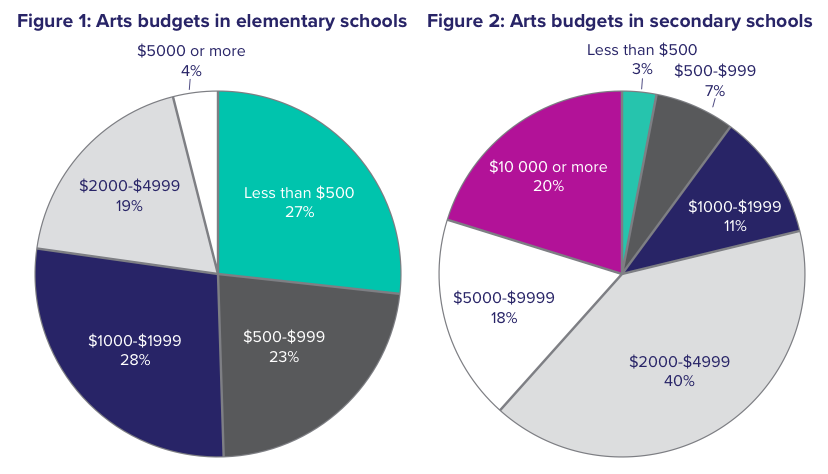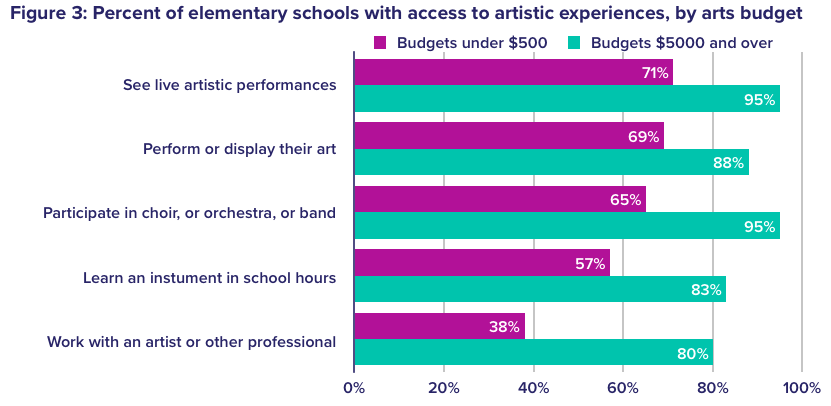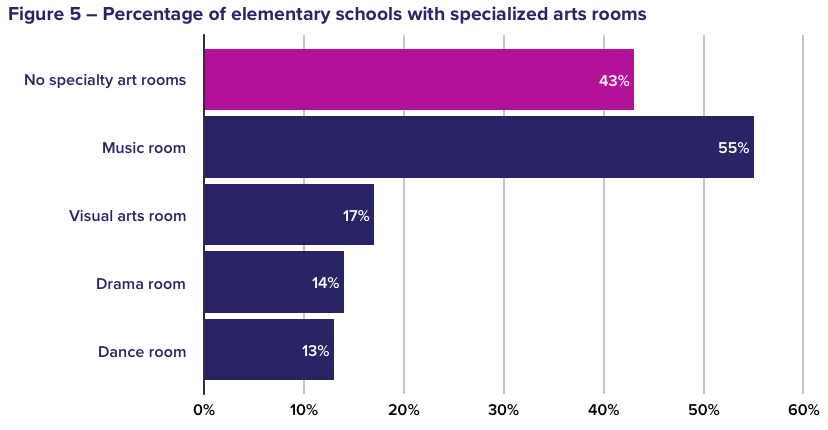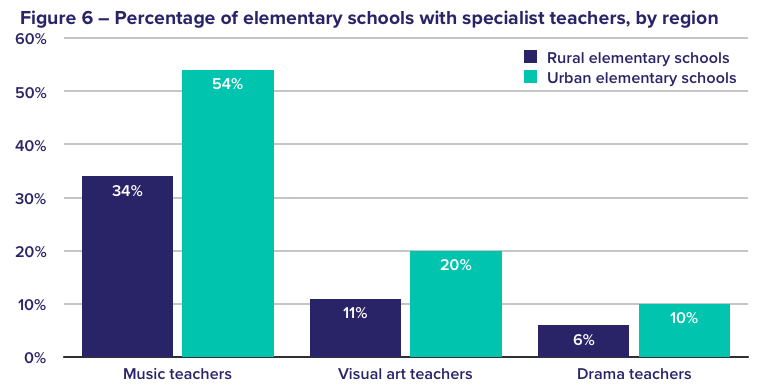How Much Money Are The Art And Music Programs In Schools
Arts teaching 2018
New information from People for Education show that, despite the widely recognized importance of arts education, equitable access to arts programs and resource is an ongoing challenge for Ontario's schools. Students in minor and rural schools, in schools with college levels of poverty, and in schools with lower levels of parental teaching are less likely to have access to learning opportunities in the arts.
Download PDF
- 46% of simple schools report having a specialist music teacher, either full- or office-time, upwards from 41% concluding year
- 98% of secondary schools offer a senior (grades 11/12) Visual Arts form, 92% offer a senior Music course, 86% offer a senior Drama course, and 32% offer a senior Dance grade
- Simple schools with high parental education are twice every bit likely to take a specialist music instructor than schools with low parental education
- School budgets for the arts range from less than $500 to $100,000
It is hard to understate the benefit derived from an educational activity in the arts. Extensive inquiry on the impact of arts didactics shows that information technology supports students' evolution in areas ranging from improved spatial reasoning (Hetland & Winner, 2001) to a deepened motivation for learning (Deasy, 2002).
Most significantly, arts instruction has the potential to enrich students' creativity and social development (Hunter, 2005). These two qualities are included in the Ministry of Education's 21st Century Competencies (Ontario, 2015), and make upwards two of five key learning domains identified in People for Education's Measuring What Matters initiative (Shanker, 2014; Upitis, 2014; People for Didactics, 2018).
Despite the widely recognized importance of arts education, equitable access to arts programs and resources is an ongoing challenge in Ontario.
While some schools can offering extracurricular arts activities such as "annual theatre productions," "monthly java houses," or a "26 week lunchtime program…run past an actor," their experience is non the norm. Students in small and rural schools, in schools with higher levels of poverty, and in schools with lower levels of parental education, are less probable to have access to learning opportunities in the arts.
Until recently, in that location was no provincial funding dedicated to the arts. School boards can determine how much funding they allocate to schools for the arts. In some cases, boards allocate money for specific arts initiatives or instructional priorities. For example, some boards provide instrumental music for all students in grades seven and 8, and will therefore provide some funding to schools for instruments. Other boards provide an instructional budget based on the amount of full-fourth dimension equivalent (FTE) music specialists at each school.
In addition to board funding, schools tin can fundraise for things like arts excursions, visiting artists, or musical instruments. Together, the funds raised past the school and allocated by the lath contribute to a school'southward arts budget for the year.
In 2018, People for Didactics asked uncomplicated and secondary schools about their arts budget. Amidst unproblematic schools, these budgets range from nether $500 to as high as $20,000 (see Figure 1). At the secondary level, arts budgets can reach as high as $100,000 (see Figure 2).

Both the data and the comments from our survey illustrate the touch of school budgets on access to resources and learning opportunities in the arts. One principal commented that "many instruments sit broken until budgetary bottom lines are adamant closer to the end of the year. Even then, not all instruments can be repaired because there is non enough money."1 Some other noted that it is "very difficult to proceed upward with maintenance and replacement costs"2 associated with their instruments.
To understand the bear on of arts budgets on students' opportunities to participate in arts enrichment, nosotros examined the difference betwixt elementary schools with the highest and everyman budgets – those under $500 and over $5000. Figure 3 shows that larger arts budgets accept a pregnant impact on arts learning opportunities for elementary students.

Lack of budget to purchase musical instruments.
Elementary school,
Conseil scolaire de district catholique de l'Est ontarien
[Translated from French]
In elementary schools, the arts budget besides appears to exist connected with the availability of arts programming space. Simple schools with an arts budget of $5000 or greater have, on average, 3 times as many types of specialty arts rooms as those with arts budgets nether $500.
Amidst secondary schools, there is a correlation between college arts budgets and the number of senior-level arts courses offered. Furthermore, secondary schools with budgets of $2000 or more are more likely to provide arts-related opportunities than those with budgets under $2000. Secondary schools with budgets of $2000 or more are:
- 11% more likely to be able to display their art
- fifteen% more than likely to run across live artistic performances
- 33% more than likely to larn an instrument in school hours
- 47% more likely to participate in a choir, orchestra, or band
- 63% more likely to work with an artist or professional from outside the school
1 This annotate is from a secondary school in Dufferin-Peel Cosmic DSB
2 This comment is from an elementary school in Lakehead DSB
There is also a clear link betwixt the amount schools fundraise and the size of their arts budgets. At the secondary level, schools who written report fundraising for the arts are 22% more likely to report an arts budget of $5000 or more. At the elementary level, this effect is even more than pronounced. Elementary schools who report fundraising for the arts are twice every bit likely to report a budget of $5000 or more.
When nosotros look at acme-decile and bottom-decile fundraising elementary schools, regardless of whether they reported raising money for the arts, the gap widens farther. The top fundraising elementary schools are nigh 3 times more likely to accept an arts budget of $5000 or more than, compared to uncomplicated schools in the lowest fundraising decile.
Much of our arts is funded through our Parent Quango, who have prioritized the arts at this school.
Elementary school,
Toronto DSB
Socio-economic condition is one of strongest predictors of academic accomplishment (Davis-Kean, 2005; Sirin, 2005). Many international organizations rail socio-economic condition through proxies such as parental education, parental occupation, family income, and resource available in the abode (eastward.g. Hooper, Mullis, Martin, & Fishbein, 2017; OECD, 2016).
This yr, we used information from Statistics Canada and Ontario's Ministry of Educational activity to look at the percentage of students from each schoolhouse whose families' after-revenue enhancement income is below the Low-Income Mensurate. Using our survey sample of elementary schools, People for Education compared the superlative quartile on this mensurate — which nosotros refer to equally high poverty schools – and the bottom quartile — referred to as low poverty schools. Nosotros too looked at the percentage of students from each schoolhouse whose parents had achieved a university accreditation. Using our sample of elementary schools, nosotros compared the elevation quartile — schools with loftier parental education — to those in the bottom quartile — with low parental educational activity.
Low poverty schools are more likely to raise more than money per school, more than money per student, and more money specifically for the arts, as compared to high poverty schools. Schools with high parental education were 10 times more likely to accept an arts budget of $5000 or more, as compared to schools with depression parental education.
Individual educators are required to integrate the arts in their classroom instruction, and ofttimes they do non have specialized preparation; therefore, these areas may not receive the attention necessary.
Uncomplicated school,
Sudbury Catholic DSB
Ontario's arts curriculum covers everything from drama to visual arts, music and dance. Information technology is very detailed, and tin pose a challenge for classroom teachers — especially in uncomplicated schools — if they do not have additional training.
On this year's survey, many principals commented that their schools struggle with a "lack of specialists" to teach the arts. This concern is supported past the survey data. In 2018, only 46% of elementary schools written report having a music teacher, either total- or part-fourth dimension. While this is an improvement over the 41% of schools reporting music teachers last twelvemonth, it is nonetheless well below the 58% of schools reporting music teachers 20 years ago. Only 16% of uncomplicated schools with grades 7 or 8 written report having a specialist visual arts instructor, and merely eight% of elementary schools with grades 7 or viii have access to a specialist drama teacher.
Access to specialist teachers — the impact of schoolhouse size
One of the factors contributing to the variation in specialist arts staff is enrolment. In this yr's survey, simple schools with a full-time music teacher average 59% more students than those without any specialist. This is direct connected to funding based on enrolment and teachers' preparation time.
School boards must provide teachers with training time, and that preparation time is usually covered past specialist teachers. Schools with more students have more teachers, which generates more preparation fourth dimension. Every bit a issue, larger schools can hire more specialist teachers to encompass that prep fourth dimension.
The bear upon of grooming time on admission to specialist teachers can exist seen in this year's survey results. As funding for preparation fourth dimension has increased from the 2016/17 school year to the 2017/eighteen schoolhouse yr (Ontario, 2016; Ontario, 2017), we are seeing an increase in the overall percentage of elementary schools reporting a music teacher, from 41% in 2017 to 46% in 2018.
Access to specialist teachers — the impact of parental education
This year's survey reveals that unproblematic schools with high parental education were twice as likely to accept a music instructor (60% of high parental education schools vs. 30% of low parental education schools), and three times as likely to have a full-fourth dimension music instructor as those with low parental didactics. These differences hold even when the data is controlled for region (rural vs. urban) and school size.
This pattern extends beyond music. Schools with grades 7 or eight in the loftier parental education quartile are ii and a half times more likely to have a visual arts teacher than unproblematic schools with depression parental teaching. High parental education unproblematic schools are iii times more likely to have a drama teacher than those with depression parental education (see Figure four).

The space volition be lost adjacent year as the schoolhouse board offers the space to provide daycare at the schoolhouse.
Uncomplicated schoolhouse, Conseil des écoles catholique du Centre-Est
[Translated from French]
Learning music, drama, dance, and visual arts requires a substantial amount of space – space for instruments and supplies, space for working with dissimilar visual arts media, and space to move around. In their comments, survey respondents frequently cite a lack of specialized space every bit a bulwark to providing arts programming. Many principals report that there is no available space considering their school is "at capacity," with one principal commenting that they "barely accept storage space, let alone boosted infinite for any learning outside of the normal classroom environment."3
In this year's survey, 43% of uncomplicated schools report that they have no specialized rooms for the arts (see Figure five). Amidst elementary schools that do have specialized rooms:
- 55% of schools accept dedicated space for music
- 17% of schools have dedicated space for visual arts
- xiv% of schools accept dedicated infinite for drama
- 13% of schools have dedicated space for trip the light fantastic
Secondary schools are more likely to take specialized arts rooms. Virtually all secondary schools (98%) have at least i room designed for instruction in the arts, and 83% report 3 or more specialized arts rooms. Visual arts rooms are the almost common, with 96% of secondary schools reporting having i. Larger schools are more likely to have more types of specialized rooms.

3 This comment is from an elementary school in Brant Haldiman Norfolk Catholic DSB
At the secondary level, students take admission to more specialized arts programs and courses. Still, several principals commented that information technology can exist a challenge for students to fit these courses into their timetables.
This twelvemonth, nosotros asked schools if they offered arts courses in the senior grades (grades xi and 12). Amongst the secondary schools participating in the survey:
- 98% of schools offer a senior Visual Arts class
- 92% of schools offer a senior Music class
- 86% of schools offering a senior Drama class
- 63% of schools offer a senior Media Arts course
- 32% of school offer a senior Trip the light fantastic class
- 23% of schools offer Exploring and Creating in the Arts
These senior level courses play a pivotal function for students seeking to develop a career in the arts, and let all students to continue developing 21st century skills throughout their secondary schoolhouse experience.
Involvement and participation in elective courses (the arts) and art extracurriculars declines as students focus increasingly on graduating in iv years with xxx credits.
Secondary school,
Waterloo Region DSB
Our school is a pocket-sized country school with only eight classrooms. Our teaching staff resource allotment doesn't afford us the opportunity to have specialist teachers.
Elementary school,
Lambton Kent DSB
Schools in rural areas face more than challenges than their urban counterparts in providing arts education. This yr's survey results show a significant gap betwixt urban and rural elementary schools in the size of their arts budgets; urban elementary schools are three times more likely to have a upkeep of $5000 or more. Rural schools are also less likely to take specialist drama, visual arts, and music teachers, or specialized arts learning spaces (see Figure 6)4.
While 37% of elementary schools in urban areas study that they do not take whatever specialized arts rooms, this rises to 53% of elementary schools in rural areas. This design holds truthful even after accounting for the touch on of school size, although the gap is not quite equally pronounced in similarly-sized schools.
The qualifications held by these educators reveal further disparities:
- Music teachers in rural uncomplicated schools are nine% less probable than those in urban elementary schools to take advanced qualifications
- Drama teachers in rural elementary schools are 68% less likely to have advanced qualifications
This is reflected in the comments on the surveys, with one main identifying the "recruitment of qualified teachers to come up to [their] small rural community"five as a challenge.

4 Visual arts and drama teachers are calculated amongst elementary schools that include grades 7 and/or 8 students only.
5 This comment is from a secondary school in Keewatin-Patricia DSB
The cost of arts activities and programs outside of the school solar day make them inaccessible to many families. This twelvemonth, using data from student questionnaires completed equally part of the Educational activity Quality and Accountability Office (EQAO) assessments, we plant that overall, 43% of class iii and 39% of class six students participate in fine art, music, or drama activities at to the lowest degree once a week when they are not at school.
Unfortunately, the variation in arts resources in schools appears to exacerbate this problem. Both form three and six students from schools with lower arts budgets were more likely to say they "never" participate in fine art, music, or drama activities outside of the schoolhouse twenty-four hour period.
Regional disparities in access to specialist teachers and specialized learning spaces also raise concerns about disinterestedness in arts education.
Given the pregnant role that arts didactics plays in supporting students' learning and development, our public schools should accept equitable access to the resources and programs that support learning in the arts.
Davis-Kean, P.E. (2005). The influence of parent educational activity and family unit income on child achievement: The indirect role of parental expectations and the domicile environs. Journal of Family unit Psychology, 19(2), 294-304.
Deasy, R.J. (2002). Critical links: Learning in the arts and student academic and social development. Washington, DC: Arts Education Partnership.
Hetland, L., & Winner, Due east. (2001). The Arts and academic accomplishment: What the evidence shows. Arts Education Policy Review, 102(5), 3-half-dozen.
Hooper, M., Mullis, I.V.South, Martin, One thousand.O., & Fishbein, B. (2017). Chapter 3: TIMSS 2019 Context Questionnaire Framework. In I.V.S. Mullis & Chiliad.O. Martin (Eds.),TIMS 2019 Cess Frameworks. Boston, MA: Boston Higher, TIMSS & PIRLS International Report Center.
Hunter, M.A. (2005). Didactics and the Arts enquiry overview. Sydney, Australia: Commonwealth of australia Council for the Arts.
Government of Ontario (2015). 21st Century Competencies. Toronto, ON: Queen's Printer for Ontario.
OECD. (2016). PISA, 2015 Results (Volume I): Excellence and Disinterestedness in Pedagogy. Paris, French republic: PISA, OECD Publishing.
Ontario Ministry of Educational activity. (2016). Education Funding: Technical Paper, 2016-17. Toronto, ON: Government of Ontario.
Ontario Ministry of Educational activity. (2017). Pedagogy Funding: Technical Paper, 2017-18. Toronto, ON: Authorities of Ontario.
People for Eduation (2018). Across the 3R'due south. Toronto, ON: People for Education.
Shanker, S. (2014). Broader Measures for Success: Social/Emotional Learning. In Measuring What Matters, People for Education. Toronto: November viii, 2014
Sirin, S.R. (2005). Socioeconomic status and academic accomplishment: A meta-analytic review of enquiry. Review of Educational Research, 75(iii), 417-453.
Upitis, R (2014). Creativity; The State of the Domain. In Measuring What Matters, People for Didactics. Toronto: Nov 8, 2014
Author
Michael Gill
Document Commendation
People for Instruction (2018). Arts education. Toronto: People for Instruction.
The People for Didactics tracking survey was adult by People for Instruction and the Metro Parent Network, in consultation with parents and parent groups across Ontario. People for Didactics owns the copyright on all intellectual property that is function of this project.
Use of any questions independent in the survey, or any of the intellectual belongings developed to support administration of the survey, is strictly prohibited without the express written permission of People for Education.
Questions almost the utilize of intellectual property should exist addressed to the Research Manager, People for Pedagogy, at 416-534-0100 or [electronic mail protected].
Data from the Survey
Specific inquiry data from the survey can be provided for a fee. Uncomplicated school data have been nerveless since 1997, and secondary schoolhouse information accept been collected since 2000. Please contact [e-mail protected].
Since you lot're here...
Did you know that People for Education conducts our ain inquiry and provides regular updates on education issues?
Sign up for our newsletter and exist the outset to get our news and reports.
Source: https://peopleforeducation.ca/report/arts-education-2018/
Posted by: cainchicter1945.blogspot.com

0 Response to "How Much Money Are The Art And Music Programs In Schools"
Post a Comment